Oh, Barry was faster than me


So, that's what I had prepared:
Hello all,
A new Drosera species has been described from the Cape area of South Africa (the article was printed today, thus that’s a brand-new species!

)
Drosera ericgreenii A. Fleischm., R.P. Gibson et Rivadavia
See: Fleischmann, A., Gibson, R. & Rivadavia, F.: “Drosera ericgreenii (Droseraceae), a new species from the fynbos of South Africa”. Bothalia 38(2): 141-144. (2008).
The article contains a detailed description of the new species, including notes on habitat, ecology and taxonomic affinities. A comparison with its closest relative - D. hilaris - is provided, as well as a b/w-drawing to illustrate D. ercigreenii, a distribution map of D. ericgreenii and D. hilaris. The article includes an identification key for all known stem-forming Drosera species of the Western Cape area.
This new species was named in honour of the South African CP expert Eric Green, who discovered countless localities of carnivorous plants in South Africa, and who originally discovered several new species of Drosera (including D. slackii, D. rubrifolia, D. coccipetala, D. cistiflora ‘Eitz’, D. afra, and others. All of which have been described without even acknowledging Eric’s invaluable help or that fact that he originally discovered those plants!). Moreover, Eric is the seed source of almost all South African Drosera which entered cultivation worldwide since several decades!
Eric, thank you again for your kind hospitality when Fernando, Robert, Kirk, Stew and I visited South Africa in 2006; for all of the inspiring discussion on CPs, but especially for botanising and exploring the Cape area, for sharing your experiences and discoveries with the CP community, and for helping to introduce so many of those South African beauties in cultivation! Without your efforts, the CP world would not be that rich in so many beautiful South African sundews!
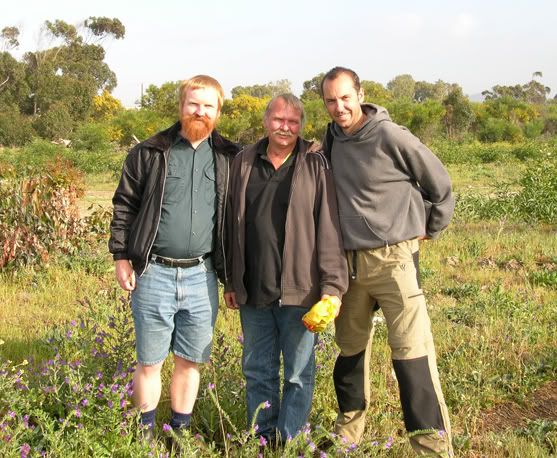
Robert, Eric and Fernando in Capetown, September 2006.
And finally a few photos to illustrate the new sundew:
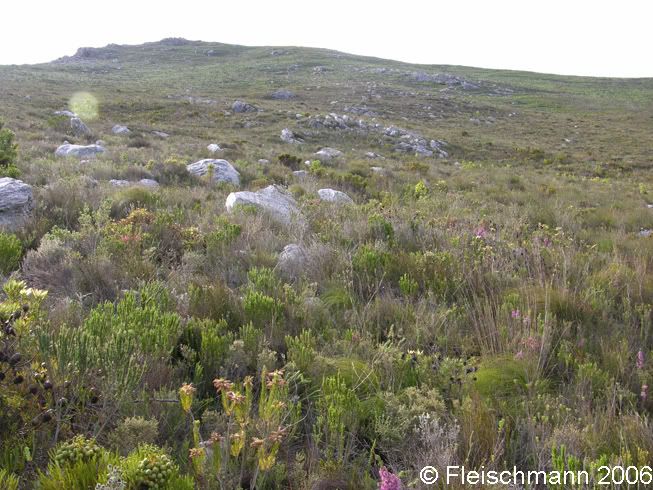
Habitat of Drosera ericgreenii: fynbos vegetation near the town of Franschhoek, Stellenbosh, Western Cape Province, South Africa. “Fynbos” is a typical vegetation type of the Cape floral area, it is draught and fire adapted ericoid scrubland (“fynbos” is derived from Afrikaans language and means “fine bush”, referring to the usually small, needle like leaves of many species growing there. Its general appearance is similar to what is called “garrigue” or “phrygana” in the Mediterranean, “campos rupestre” in Brazil, “chaparral” in the American West or the “open heathlands” in Western Australia).

Drosera ericgreenii prefers to grow in slight shade of shrubs or rocks, on rather dry, sandy soil.
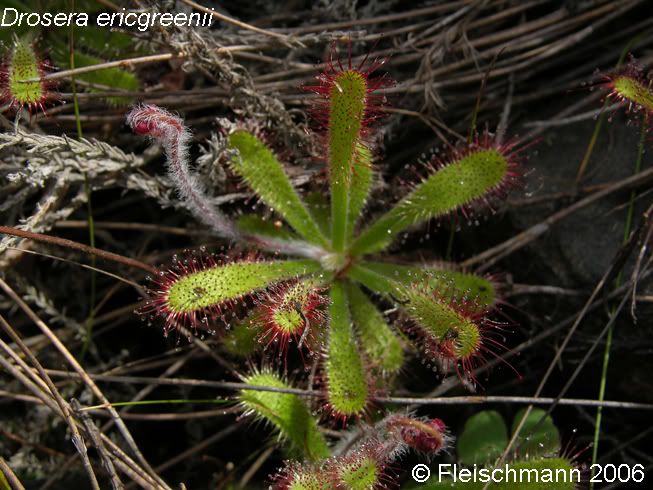

Note the very hairy scape of Drosera ericgreenii, which is ascending from the base. In D. hilaris, the scape is growing upright from the centre of the plant.
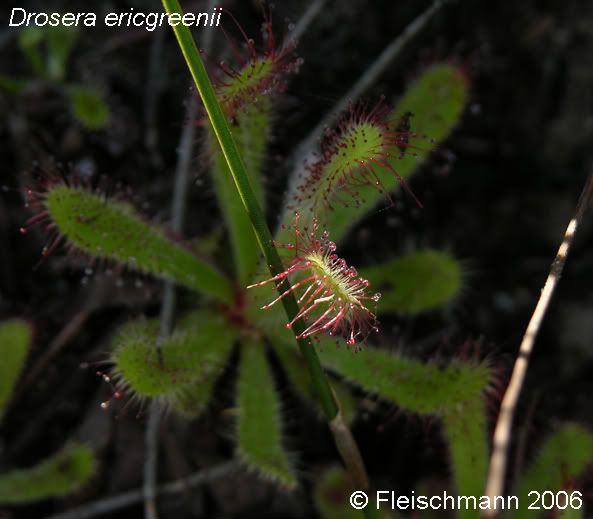
Close-up of the enlarged unifacial glands at the margins of the leaf tip. Drosera hilaris, for comparison, does only have sticky glands with knob-like heads all over the leaf surface.
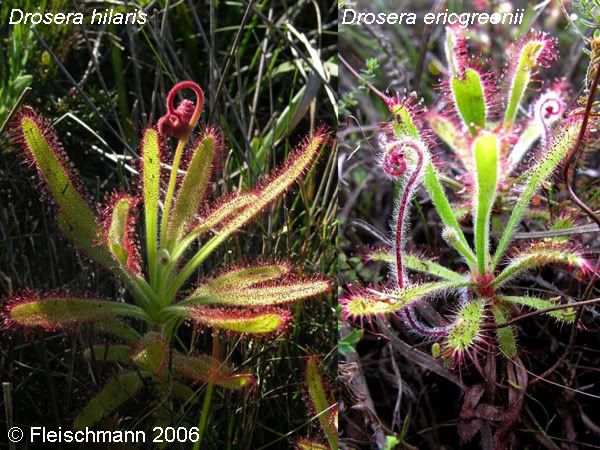
Comparison of the two related species Drosera hilaris and D. ericgreenii (photo of D. ericgreenii by Fernando Rivadavia). Note the conspicuous reddish stipules of D. ericgreenii. In D. hilaris, the stipules are barely visible, as they are reduced to tiny setae.
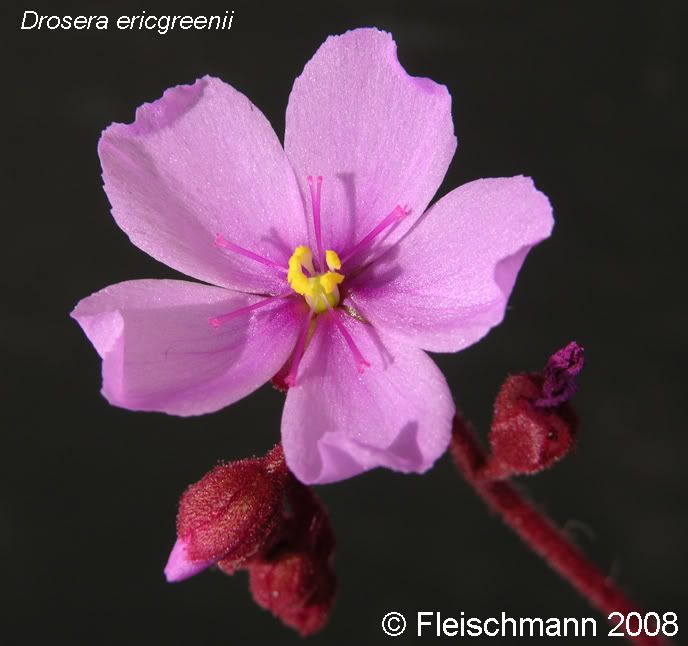
Flower of D. ericgreenii.

Drosera ericgreenii in cultivation. I grow this plant under identical conditions to D. hilaris or D. ramentacea (i.e. deep pots up to 30 cm, 50:50-sand:peat mix, substrate only moist, not soaking wet year round, in full sun in my cool greenhouse, a lot of air movement for cooling and to prevent rot). It’s a South African montane species, and therefore somewhat demanding in cultivation (for sure not a beginner’s plant!). Like several other mountain sundews from the Cape (D. glabripes, D. hilaris, D. ramentacea, D. regia) it prefers cool temperatures, especially of the soil. If the roots get exposed to warmer temperatures for too long, the root system is likely to be damaged and will rot easily. However, under good growing conditions this species can be grown from seed to flowering plants within 3 years!
I don’t have any spares of D. ercigreenii at the moment, but have sent all of the seed I could harvest from my cultivated plants (it is self-fertile, but not selfing, like most South African Drosera) to some experienced friend growers fro propagation and further distribution. Hopefully this nice plant will enter some more Drosera collections worldwide soon!
All the best,
Andreas







